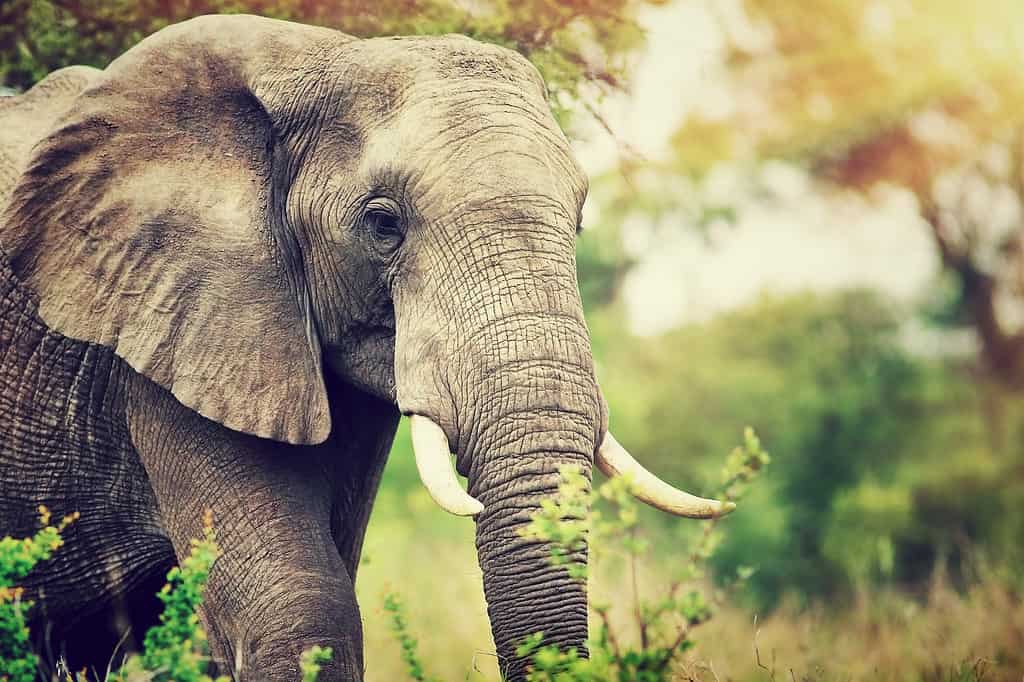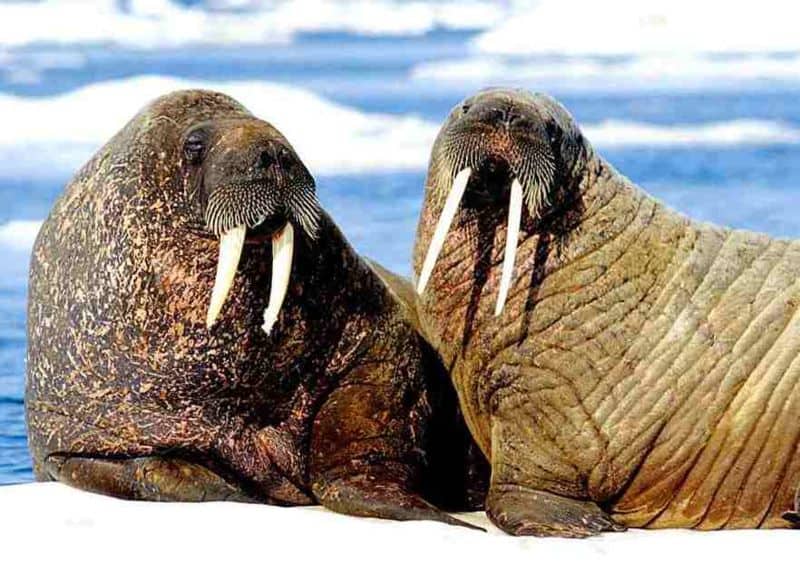The walrus (Odobenus rosmarus) is an animal that most people easily recognize. With its massive body and large ivory tusks, this sociable creature is loved by many. This marine mammal inhabits the Northern Pacific and Northern Atlantic Oceans near the Arctic Circle. It is notable for its sensitive whiskers, large bulky body, and ivory tusks. In this article, we are going to focus on the walrus’s tusks. We are going to uncover how big they get, how they evolved, and all the things you need to know about this incredible body part. Let’s dive in!
How Big Does a Walrus Get?

One of the reasons walruses are so bulky is because of their blubber, which they use as insulation and as a food reserve.
©Ondrej Prosicky/iStock via Getty Images
Before divulging how big their tusks get, we should first understand how large of an animal the walrus is in general. While it may not compare to the size of an elephant or a blue whale, the walrus is not far behind in size compared to the largest mammals. These large mammals have rounded heads, wrinkly brown skin, and flat flippers.
Although they look awkward on land, there is a purpose for these animals being so bulky. Part of their bulk is due to their thick layer of blubber. Walruses have this layer of blubber to help keep them insulated in the cold ocean temperatures of their habitat. Additionally, they can use that blubber as energy reserves when food is scarce.
There are two types of walrus, the Atlantic walrus (Odobenus rosmarus rosmarus) and the Pacific walrus (Odobenus rosmarus divergens). Both get quite large. The Atlantic walrus males average around 2,000 pounds, and females are between 800-1,230 pounds. The Pacific walrus males are even larger, weighing an average of 4,400 pounds, and the females between 1,800-3,700 pounds.
Now that we see how large of a mammal this creature is, it makes sense that their tusks would also be massive, but how big do they truly get?
How Big Does a Walrus’s Tusks Get?
Now that you have an understanding of just how big this animal gets, we will discuss the size of their impressive tusks. Both male and female walruses have tusks, although the males tend to have longer and straighter tusks than the females. The tusks of the walrus are actually their teeth! While the average walrus has 18 teeth, the tusks are their two canine teeth. Male walrus tusks can grow up to 39 inches long and female walrus tusks can grow up to 31.5 inches long. The average weight of a walrus tusk is between 11 and 15 pounds each.
Despite them being teeth, their primary function is not for eating. The main purpose of the tusks is to establish dominance in social settings. Additionally, walruses use these tusks to assist in hauling their bodies out of the water and onto ice or rocky shores. The walrus tusks may also be used for fighting or defensive tactics during breeding season. Walruses with larger tusks will assert dominance over those with smaller tusks. Then, those walruses of similar tusk size will fight, they may raise their tusks into the air or jab their opponent with them.
Elephant vs Walrus Tusks: What Is The Difference?

Both elephant and walrus tusks are made of ivory, however, elephants are poached illegally whereas walrus harvests and ivory are federally protected.
©Anna_Om/iStock via Getty Images
Another animal that is well known for their tusks is the elephant. Although an entirely different animal from the walrus, they do have some similarities with their tusks. Similarly to the walrus, the tusks of the elephant are their teeth. With the elephant, the tusks are their upper second incisors, that morphed into the tusks over time. Additionally, the elephant tusks continue to grow throughout their life, just like the tusks of some male walruses.
While the walrus do not use their tusks for foraging food, elephants do. They use their tusks to dig for food and water as well as defend themselves and lift heavy objects. Both the elephant and walrus tusks are made of ivory, and unfortunately, both animals suffer from people who hunt them for their tusks. However, Alaska Native people have responsibly harvested walrus and other marine mammals whereas the elephants have been poached to the point where it is now illegal to hunt and kill them for their ivory tusks.
Similarly to the walrus, the female elephants have smaller tusks than the males. However, the elephant tusks are dramatically larger and heavier than the walrus tusks. An adult male tusk weighs between 110-175 pounds and an adult female tusk weighs between 40-44 pounds. Their permanent tusks continuously grow at a rate of about 6.7 inches per year. Some elephant tusks have reached lengths of up to 7.7 feet.
How Tusks Evolved
While various animals have tusks, not many people know of their origin or how these animals came to have them. One similarity that all tusked animals share is that they are all mammals. There are currently no known fish, birds, or reptiles that have tusks. Ken Angielczyk, a curator at the Field Museum in Chicago, explains how “the first tusks belonged to animals that came before the modern mammals, called dicynodonts.”
These animals ranged from rat to elephant size and lived about 270-201 million years ago. While these animals had a more reptilian appearance, they are most closely related to the mammals of today. The term dicynodont means “two canine teeth.” However, to be considered a tusk, researchers agreed that the tooth must extend out past the mouth, continue growing throughout the animal’s life, and be made of dentine.
These scientists also discovered adaptations that these animals had to develop to evolve the modern-day tusks we see today. Those adaptations include flexible ligament attachments between tooth and jaw and reduced rates of tooth replacement. While there is still more research being done in this field, and more research is needed specifically in regards to how many times tusks have evolved and why, these studies help give us an understanding of the origin of tusks and how these tusked mammals are similar.
Walrus Fun Facts

Walruses use their tusks as a multipurpose tool.
©Ansgar Walk / CC BY-SA 3.0 – License
- A single walrus has between 400 and 700 whiskers.
- Walruses can whistle.
- A walrus’s tusks grow for about 15 years, although in males some will continue to grow.
- Walruses have just two natural predators, the polar bear and the orca.
- When swimming, a walrus uses its foreflippers for steering.
- Baby walruses do not have tusks when they are born, their tusks emerge from their gums when they reach about 6 months of age.
The photo featured at the top of this post is © Joel Garlich-Miller, U.S. Fish and Wildlife Service, Public domain – License / Original
Thank you for reading! Have some feedback for us? Contact the AZ Animals editorial team.







